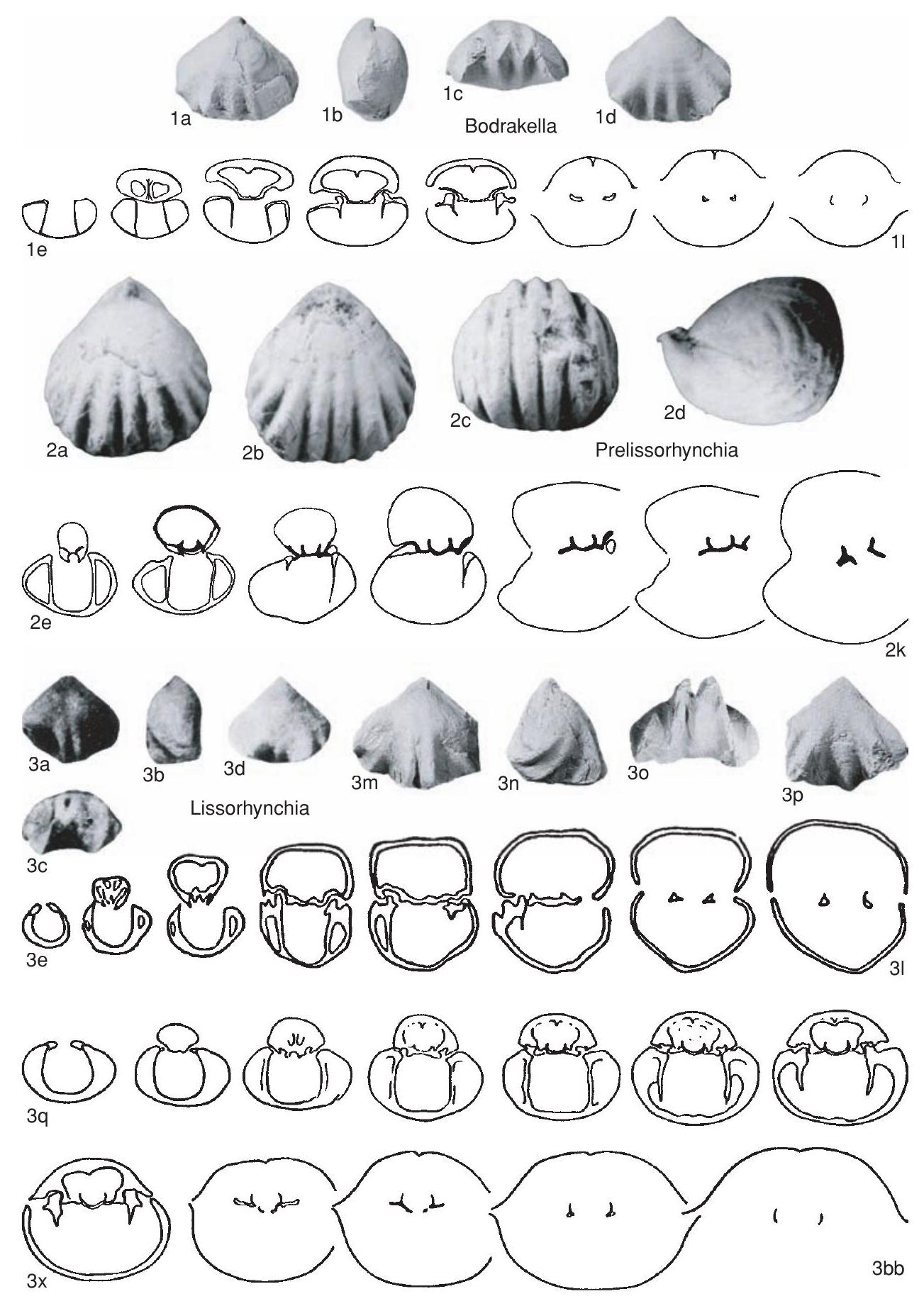Welcome to the Treatise on Invertebrate Paleontology!
Please enter a genera name to retrieve more information.

Lissorhynchia
Classification
Phylum:
Brachiopoda
Subphylum:
Rhynchonelliformea
Class:
Rhynchonellata
Order:
Rhynchonellida
Superfamily:
Wellerelloidea
Family:
Pontisiidae
Subfamily:
Pontisiinae
Formal Genus Name and Reference:
Lissorhynchia Yang & XU, 1966, p. 14
Type Species:
L. pygmaea, OD
Images
(Click to enlarge in a new window)
Fig. 867, 3a-l. * L. pygmaea, Anisian, Gheizhou, China, a-d, holotype, dorsal, lateral, anterior, ventral views, MCMB DDR VI 1, x2, e-l, paratype, transverse serial sections, distances in mm from ventral umbo, 0.4, 0.8, 0.9, 1.1, 1.2, 1.35, 1.4, 1.8, MCMB DDR VI 1-2 (Yang & Xu, 1966).——Fig. 867, 3m-bb. L. vesca (Dagys), Induan, Scythian, northwestern Caucasus, m-p, holotype, dorsal, lateral, anterior, ventral views, IGiG 394/71, x2, q-b b, transverse serial sections, distances in mm from first section, 0.1, 0.2, 0.4, 0.6, 0.66, 0.76, 0.96, 1.16, 1.31, 1.41, 1.51, 1.76, IGiG 394/72 (Dagys, 1974).
Synonyms
Neowellerella
Geographic Distribution
Caucasus, Russia, Lower Triassic, Alps, Himalayas, southwestern China (southern Qilian), Middle Triassic
Age Range
Beginning Stage in Treatise Usage:
Lower Triassic (Scythian)
Beginning International Stage:
Induan
Fraction Up In Beginning Stage:
0
Beginning Date:
251.9
Ending Stage in Treatise Usage:
Middle Triassic
Ending International Stage:
Ladinian
Fraction Up In Ending Stage:
100
Ending Date:
237
Description
Small, subtrigonal to subpentagonal, dorsibiconvex, with flattened ventral valve, smooth posteriorly, with ventral sulcus and dorsal fold developed anteriorly, commissure uniplicate bidentate, each lateral slope bearing pair of marginal plicae, beak small, slightly incurved, disjunct deltidial plates narrow, foramen small, submesothyrid to hypothyrid. Muscle scars elongate oval, indistinctly differentiated into several pairs, septalium very small, median ridge exceedingly short and crura short and slightly incurved.
References
Museum or Author Information
Classification
Phylum:
Brachiopoda
Subphylum:
Rhynchonelliformea
Class:
Rhynchonellata
Order:
Rhynchonellida
Superfamily:
Wellerelloidea
Family:
Pontisiidae
Subfamily:
Pontisiinae
Formal Genus Name and Reference:
Lissorhynchia Yang & XU, 1966, p. 14
Type Species:
L. pygmaea, OD
Images
(Click to enlarge in a new window)
Fig. 867, 3a-l. * L. pygmaea, Anisian, Gheizhou, China, a-d, holotype, dorsal, lateral, anterior, ventral views, MCMB DDR VI 1, x2, e-l, paratype, transverse serial sections, distances in mm from ventral umbo, 0.4, 0.8, 0.9, 1.1, 1.2, 1.35, 1.4, 1.8, MCMB DDR VI 1-2 (Yang & Xu, 1966).——Fig. 867, 3m-bb. L. vesca (Dagys), Induan, Scythian, northwestern Caucasus, m-p, holotype, dorsal, lateral, anterior, ventral views, IGiG 394/71, x2, q-b b, transverse serial sections, distances in mm from first section, 0.1, 0.2, 0.4, 0.6, 0.66, 0.76, 0.96, 1.16, 1.31, 1.41, 1.51, 1.76, IGiG 394/72 (Dagys, 1974).
Synonyms
Neowellerella
Geographic Distribution
Caucasus, Russia, Lower Triassic, Alps, Himalayas, southwestern China (southern Qilian), Middle Triassic
Age Range
Beginning Stage in Treatise Usage:
Lower Triassic (Scythian)
Beginning International Stage:
Induan
Fraction Up In Beginning Stage:
0
Beginning Date:
251.9
Ending Stage in Treatise Usage:
Middle Triassic
Ending International Stage:
Ladinian
Fraction Up In Ending Stage:
100
Ending Date:
237
Description
Small, subtrigonal to subpentagonal, dorsibiconvex, with flattened ventral valve, smooth posteriorly, with ventral sulcus and dorsal fold developed anteriorly, commissure uniplicate bidentate, each lateral slope bearing pair of marginal plicae, beak small, slightly incurved, disjunct deltidial plates narrow, foramen small, submesothyrid to hypothyrid. Muscle scars elongate oval, indistinctly differentiated into several pairs, septalium very small, median ridge exceedingly short and crura short and slightly incurved.
